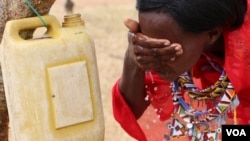KAJIADO, KENYA —
Health workers in Kenya say more than 60,000 people are living with trachoma, an infectious eye disease that causes blindness if not treated early. But doctors are working to bring an outbreak of the disease under control in Kajiado, a remote rural village in southern Kenya.
A local trachoma monitor in Kajiado is teaching a group of women how to prevent the eye disease and how, and where, to get treatment.
Lester Mortai is well known in this area for his work fighting trachoma. He travels through villages, telling people the best ways to avoid getting the painful disease.
“At household level I encourage them face cleanness and even the environment. [In] the case of trachoma, the main agent is the flies. We also encourage those who sleep [with] animals around them to separate themselves from animals,” said Mortai.
Trachoma is characterized by the swelling of the eyelids and scarring of the outer surface of the eye, the cornea. Repeated infections make the eye lashes turn in and scratch the cornea, causing pain and, eventually, blindness.
According to the African Medical and Research Foundation (AMREF), more than 7,000 people in Kajiado suffer from trachoma. The disease primarily afflicts impoverished pastoral communities.
Ngeyan Nge is one of four trachoma sufferers with an advanced stage of the disease. To avoid blindness, Nge will undergo surgery to correct the positioning of her eye lashes. The mother of six says she decided to seek medical treatment after a long time living with pain.
She said she was now hopeful about the future, even though in the beginning she was opposed to the surgery. She changed her mind, adding, "after continuous advice from people, and also no matter what medicine I use the pain won’t go away. After the surgery, I hope I will be able to see well and carry my daily activities.”
One of the "flying doctors" from AMREF, John Soine, travels to remote areas of Kenya every week to operate on those with serious cases of trachoma. He said the disease was easily treatable if caught early.
“If these people with active infections are not treated, they end up developing complications whereby the eyelashes start facing inwards and start rubbing on the eye ball. And at this stage one may lose vision. And the loss of vision in trachoma is irreversible,” he said.
Thirty-nine-year-old Kadogo Salaash had almost lost her vision to the disease more than five years ago. At first she was doubtful that surgery could help her, but eventually she relented.
“When I decided to go for the eye surgery, I was worried and uncomfortable,” she said. “I thought after the surgery I would not see again. [But now it’s the opposite; I am confident, happy and I can do my work well.”
Health workers said in the last five years active trachoma prevalence has dropped by 11 percent, largely due to vigorous education campaigns and improved access to water, sanitation and hygiene.
The next goal is to reduce active trachoma prevalence to under 10 percent, with hopes of eliminating the disease entirely by 2020.
A local trachoma monitor in Kajiado is teaching a group of women how to prevent the eye disease and how, and where, to get treatment.
Lester Mortai is well known in this area for his work fighting trachoma. He travels through villages, telling people the best ways to avoid getting the painful disease.
“At household level I encourage them face cleanness and even the environment. [In] the case of trachoma, the main agent is the flies. We also encourage those who sleep [with] animals around them to separate themselves from animals,” said Mortai.
Trachoma is characterized by the swelling of the eyelids and scarring of the outer surface of the eye, the cornea. Repeated infections make the eye lashes turn in and scratch the cornea, causing pain and, eventually, blindness.
According to the African Medical and Research Foundation (AMREF), more than 7,000 people in Kajiado suffer from trachoma. The disease primarily afflicts impoverished pastoral communities.
Ngeyan Nge is one of four trachoma sufferers with an advanced stage of the disease. To avoid blindness, Nge will undergo surgery to correct the positioning of her eye lashes. The mother of six says she decided to seek medical treatment after a long time living with pain.
She said she was now hopeful about the future, even though in the beginning she was opposed to the surgery. She changed her mind, adding, "after continuous advice from people, and also no matter what medicine I use the pain won’t go away. After the surgery, I hope I will be able to see well and carry my daily activities.”
One of the "flying doctors" from AMREF, John Soine, travels to remote areas of Kenya every week to operate on those with serious cases of trachoma. He said the disease was easily treatable if caught early.
“If these people with active infections are not treated, they end up developing complications whereby the eyelashes start facing inwards and start rubbing on the eye ball. And at this stage one may lose vision. And the loss of vision in trachoma is irreversible,” he said.
Thirty-nine-year-old Kadogo Salaash had almost lost her vision to the disease more than five years ago. At first she was doubtful that surgery could help her, but eventually she relented.
“When I decided to go for the eye surgery, I was worried and uncomfortable,” she said. “I thought after the surgery I would not see again. [But now it’s the opposite; I am confident, happy and I can do my work well.”
Health workers said in the last five years active trachoma prevalence has dropped by 11 percent, largely due to vigorous education campaigns and improved access to water, sanitation and hygiene.
The next goal is to reduce active trachoma prevalence to under 10 percent, with hopes of eliminating the disease entirely by 2020.






